What is an Oil Cooler?
An oil cooler is a heat exchanger that maintains optimal oil temperature in engines, transmissions, and industrial machinery by dissipating excess heat. Proper oil cooling:
- Prevents thermal breakdown of lubricants
- Maintains ideal viscosity
- Extends equipment lifespan
Types of Oil Coolers
1. Air-Cooled Oil Coolers
- Design: Finned tubes with airflow (natural or forced)
- Best For:
- Automotive applications
- Mobile equipment
- Small industrial systems
- Advantages:
- No water required
- Simple installation
- Disadvantages:
- Less efficient in high ambient temps
2. Water-Cooled Oil Coolers
- Design: Shell-and-tube or plate-type with coolant
- Best For:
- Marine engines
- Large industrial machinery
- High-performance vehicles
- Advantages:
- Consistent cooling
- Compact design
- Disadvantages:
- Requires coolant system
3. Plate-Type Oil Coolers
- Best For:
- Space-constrained installations
- Hydraulic systems
- Advantages:
- High efficiency
- Lightweight
- Disadvantages:
- Higher cost
4. Tube-and-Fin Coolers
- Design: Bundles of tubes with external fins
- Best For:
- Heavy-duty applications
- Construction equipment
- Advantages:
- Durable construction
- Handles high pressures
- Disadvantages:
- Larger footprint
Key Benefits of Oil Cooling
Oil Cooler Applications
| Industry | Typical Use |
| Automotive | Engine/transmission cooling |
| Marine | Gearbox and hydraulic systems |
| Industrial | Compressors, turbines, presses |
| Aerospace | Aircraft engine lubrication |
| Energy | Wind turbine gearboxes |
Selection Criteria
- Oil Flow Rate (GPM/LPM)
- Temperature Requirements (inlet/outlet)
- Pressure Rating (PSI/bar)
- Space Constraints
- Ambient Conditions
Sizing Tip: Choose a cooler rated for 20-30% more capacity than your calculated heat load.
Installation Best Practices
- Mount in clean airflow (air-cooled)
- Use proper fittings/seals to prevent leaks
- Install thermostatic bypass valves
- Position below oil level when possible
- Include pressure gauges for monitoring
Maintenance Requirements
- Monthly: Inspect for leaks/damage
- Quarterly: Clean fins/tubes
- Annually: Test thermostatic controls
- Biannually: Flush water-cooled systems
Critical Warning Signs:
- Rising oil temperatures
- Pressure drops
- Visible contamination
